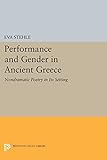Performance and Gender in Ancient Greece : Nondramatic Poetry in Its Setting / Eva Stehle.
Material type: TextSeries: Princeton Legacy Library ; 331Publisher: Princeton, NJ : Princeton University Press, [2014]Copyright date: ©1997Edition: Course BookDescription: 1 online resource (386 p.)Content type:
TextSeries: Princeton Legacy Library ; 331Publisher: Princeton, NJ : Princeton University Press, [2014]Copyright date: ©1997Edition: Course BookDescription: 1 online resource (386 p.)Content type: - 9780691602431
- 9781400864294
- 881/.0109 20
- PA3067 .S74 1997eb
- online - DeGruyter
- Issued also in print.
| Item type | Current library | Call number | URL | Status | Notes | Barcode | |
|---|---|---|---|---|---|---|---|
 eBook
eBook
|
Biblioteca "Angelicum" Pont. Univ. S.Tommaso d'Aquino Nuvola online | online - DeGruyter (Browse shelf(Opens below)) | Online access | Not for loan (Accesso limitato) | Accesso per gli utenti autorizzati / Access for authorized users | (dgr)9781400864294 |
Frontmatter -- Contents -- Preface -- Abbreviations -- Introduction -- CHAPTER ONE. Community Poetry -- CHAPTER TWO. Women in Performance in the Community -- CHAPTER THREE. Male Performers in the Community -- CHAPTER FOUR. Bardic Poetry -- CHAPTER FIVE. The Symposium -- CHAPTER SIX. Sappho's Circle -- Conclusion -- Appendix: Chronology of Primary Sources -- Transliterated Terms -- Bibliography -- Index Locorum -- General Index
restricted access online access with authorization star
http://purl.org/coar/access_right/c_16ec
"Like love, Greek poetry was not for hereafter," writes Eva Stehle, "but shared in the present mirth and laughter of festival, ceremony, and party." Describing how men and women, young and adult, sang or recited in public settings, Stehle treats poetry as an occasion for the performer's self-presentation. She discusses a wide range of pre-Hellenistic poetry, including Sappho's, compares how men and women speak about themselves, and constructs an innovative approach to performance that illuminates gender ideology. After considering the audience and the function of different modes of performance--community, bardic, and closed groups--Stehle explores this poetry as gendered speech, which interacts with performers' bodily presence to create social identities for the speakers. Texts for female choral performers reveal how women in public spoke in order to disavow the power of their speech and their sexual power. Male performers, however, could manipulate gender as an ideological system: they sometimes claimed female identity in addition to male, associated themselves with triumph over a defeated (mythical) female figure, or asserted their disconnection from women, thereby creating idealized social identities for themselves. A final chapter concentrates on the written poetry of Sappho, which borrows the communicative strategy of writing in order to create a fictional speaker distinct from the singer, a "Sappho" whom others could re-create in imagination.Originally published in 1997.The Princeton Legacy Library uses the latest print-on-demand technology to again make available previously out-of-print books from the distinguished backlist of Princeton University Press. These editions preserve the original texts of these important books while presenting them in durable paperback and hardcover editions. The goal of the Princeton Legacy Library is to vastly increase access to the rich scholarly heritage found in the thousands of books published by Princeton University Press since its founding in 1905.
Issued also in print.
Mode of access: Internet via World Wide Web.
In English.
Description based on online resource; title from PDF title page (publisher's Web site, viewed 30. Aug 2021)


